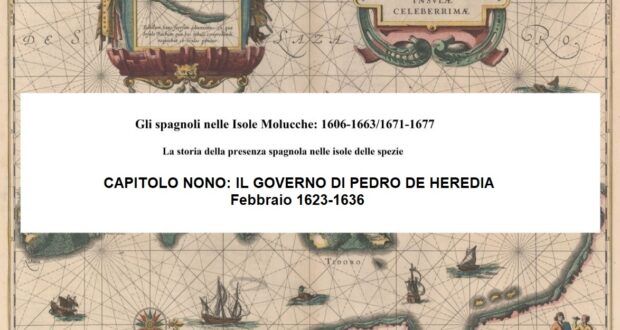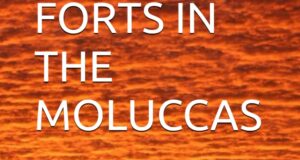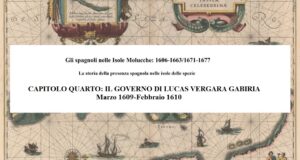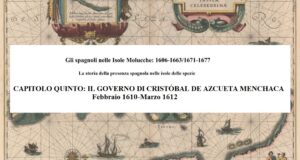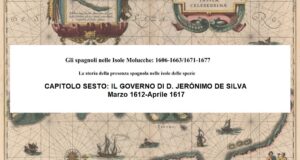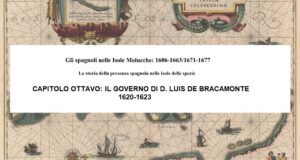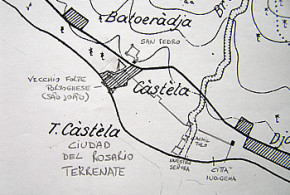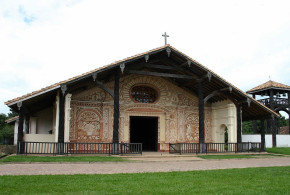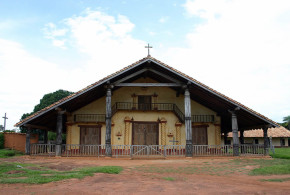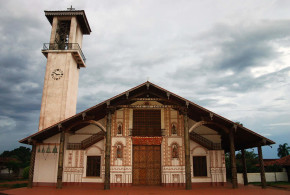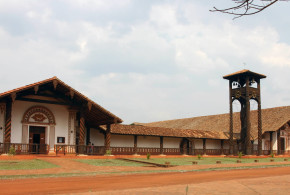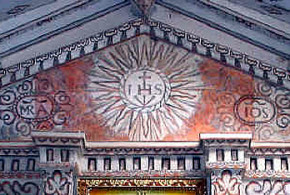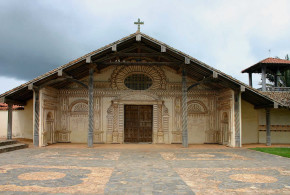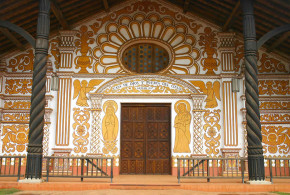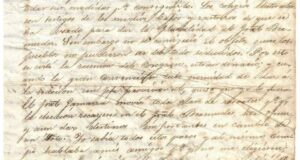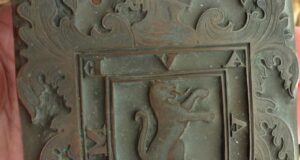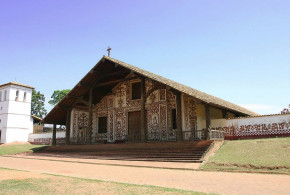This post is also available in:
![]() Italiano
Italiano
The Spaniards in the Moluccas: 1606-1663/1671-1677. The history of the Spanish presence in the spice islands
Written by Marco Ramerini. 2005-2020/23
CHAPTER NINE: THE GOVERNMENT OF PEDRO DE HEREDIA, February 1623-1636
THE ARRIVAL OF PEDRO DE HEREDIA IN TERNATE
Pedro de Heredia was a veteran of the Moluccas, and as governor he will set a record of tenure as he ruled the Moluccas continuously from 1623 to 1636. A highly experienced soldier, he had served the King of Spain before becoming governor of the Moluccas in military campaigns in Italy, Flanders and Brittany.
In 1605 he arrived in the Philippines with the position of ensign with the troops of Esquivel, which the king had sent to conquer Ternate. He participated, embarked on the captain ship, in the Ternate expedition of 1606, which led to the conquest of the fortress of Ternate. Then in the following years he served the King in Ternate with various positions including those of infantry captain, head of the galleys and sergeant major. He conquered and sacked twice the village of Gran Bocanora, and the fort of Jilolo.
His most important success was the capture in 16091 of the Dutch admiral van Caerden. Before Esquivel’s death in March 1609, he was promoted to captain and sergeant major. He later participated in several clashes with the Dutch in the Philippines. He returned to Ternate on the occasion of de Silva’s expedition of 1611 with the position of admiral, he was then appointed by him sergeant major of the “presidios” of the Moluccas.2
In 1620 we find him in Spain where he will be appointed by the King, on December 24, 1620, “alcaide de Terrenate y gobernador de la gente de Guerra de aquel presidio”, but he will only take office in 1623, due to the long return journey from Spain.3
In May 1623, the new governor of the Spanish garrisons of the Moluccas, D. Pedro de Heredia, departed from Manila with a fleet of eight ships (2 galleys, 2 “pataches”, 2 frigates and 2 “champanes”). After a stop in the port of Otong, the expedition headed for the island of Celebes, where the Spaniards maintained relations with the kingdom of Manados, here Heredia promised the king to send again as soon as possible a Spanish garrison, which had been withdrawn by the previous governor D. Luis de Bracamonte.4 The governor was accompanied to Ternate by his wife (Francisca de Guzman) and his son.5
The promise made to the king of Manado was promptly kept by Heredia, in fact Pedro de Heredia, established a fort in the northern part of the island of Celebes, in Manados, this fortified post was important for the Spanish garrisons because the area in which it was located produced a lot of rice, an essential food for the sustenance of the garrisons of Ternate. Heredia requested a force of 50 soldiers from the governor of the Philippines to garrison the new fort. Furthermore, he declared himself in favor of the return of the old sultan Said Berkat to Ternate.6
A LARGE DUTCH FLEET ARRIVES
In 1625 a large Dutch fleet, consisting of 11 boats and with 800 men on board reached Ternate.7 The Heredia letter of 4 April 1625, which gives us news of the arrival of this fleet, indicates that “A 5 deste março passado dieron fondo 14 navios delos estatos de Olanda en su fuersas de Malayo que estan dos leguas destas y segun esauido por algunos de ellos que ecoxido en tierra pasaron por el nuevo estrecho de Mayres junto al de Magallanes y corrieron las costas del Piru y Nu.a Spaña”.
The situation is confused by the notes on the left of the map (probably added by some royal official) where the year of the arrival of the boats is clearly indicated, “Que a cinco de março de 624 dieron fondo 14 nauios de los estados de Olanda en sus fuerças de Malayo”. What is reported in the note is certainly wrong, in fact, further on Heredia informs us that the general at the head of this fleet died in the port of Callao (Peru).
The fleet in question is certainly the “Nassausche Vloot” commanded by Admiral Jacques l’Hermite, in fact he will die on June 2, 1624 in front of the port of Callao, after his death the command was taken by Vice Admiral Gheen Huigen Schapenham. This fleet, made up of 12 vessels, had left Holland at the end of April 1623 and sailed through the Strait of Le Maire, then sailed up the coast of South America, where it raided the coasts of New Spain and Peru, from here it then reached Ternate where it arrived, as Heredia informs us, on 5 March 1625.8 Another letter, written from Manila to the King, also removes any doubts about the month of arrival of this Dutch fleet, this letter informs us that in March 1625, 14 large Dutch galleons arrived in Ternate, they came from Peru, where the previous year they had plundered its coasts.9 In this period, Pedro de Heredia should have, according to the King, 10 boats at his disposal to oppose the Dutch.10
THE DUTCH ABANDON THE FORT OF CALOMATA
In March 1625 the Dutch dismantled and abandoned the fort of Calomata, which was located within musket range of the Spanish (Don Gil’s) fort. The Spanish shortly afterwards, probably in January 1626, rebuilt and occupied the Calomata fort, which was located half a league from Malayo and had been dismantled by the Dutch shortly before. The occupation of the fort was carried out to prevent a new occupation of Calomata by the Dutch. With the occupation of the fort of Calomata, the Spaniards abandoned the fort of Santa Lucia, which was no longer of any use. In the same month of March 1625, the Dutch also dismantled the fort on the island of Moti, however it seems that in this case the Spaniards did not occupy the place with their own garrison. In April 1625, the Dutch probably also dismantled the fortress of Bachian “Y al presente an ydo a rretirarla del Reyno de Ba(?)jan”. The new relief fleet arrived at Ternate undamaged. In this period both Ternate and Tidore are at peace with the Spanish.11
However, despite the Dutch, in 1625, the Spanish forts of the Moluccas are well supplied with troops and supplies, Fernando de Silva tells us about this. While several grievances have reached Fernando de Silva about the work of Governor Pedro de Heredia, he is accused of trading with the Dutch and of subtracting taxes for the export of cloves. His letter also confirms that the Dutch have dismantled the forts of Calomatas and Motil. The Spanish again consider returning the old sultan, Said Berkat, to Ternate, who is still a prisoner in Manila. It seems at the express request of some Ternatese who in return promise a peace treaty with Spain.12
The condition of the Spanish garrisons in 1626 is the best it has ever been, for while supplies from Manila have arrived without loss, the Dutch have been helpless since the year before. It seems that the war in Flanders is hampering the arrival of reinforcements from Holland beyond measure. In 1626 the old king of Tidore died, one of his sons succeeded him to the throne. In the same year, the Ternatese made peace with the Spaniards and asked for the return of their old sultan, still a prisoner in Manila. The Dutch have no fleets in the Moluccas this year, they have 5 or 6 forts on the islands of Ternate, Machien and Motiel and a garrison of just 200 men in total. Spanish reports describe the Dutch position as very precarious, several defections in the Dutch ranks are reported, 6 or 8 Dutch soldiers went over to the Spanish in 1626.13 Heredia, requested in Manila the return to Ternate of the old sultan, the governor of the Philippines Niño de Tavora expressed a favorable opinion on the return of the sultan, but before carrying out such an act, he expressly requested the opinion of the King by letter.14 The sultan will never return to Ternate, because he will die in Manila in 1628.
THE SITUATION OF RELIGIOUS IN TERNATE
It is not clear in which year (in 1626 or in 1628), but both the convent and the adjoining royal hospital that the Franciscans had founded in Ternate caught fire, with them also burning a considerable part of the native village. It seems that the Franciscans after this misfortune wanted to leave Ternate, but the governor of the Philippines Juan Niño de Tavora prevented them from returning to Manila. The governor ordered Pedro de Heredia to rebuild the convent, which he did in a short time and with particular care, this time it was rebuilt entirely in stone.15 In 1626, Pedro de Heredia, rebuilt the convent of the Franciscan friars of Ternate (convent of San Antonio de Terrenate) at his own cost, with lime and stone.16 It seems that around these years the Augustinian convent of Ternate was abandoned.17
THE “SOCORRO” OF 1627
The reinforcements for Ternate in 1627 (late 1627 or early 1628) consisted of three “pataccos” captained by Francisco Hernandez18, they are attacked in sight of Ternate by a large and well equipped Dutch boat, two of the Spanish ships manage to take refuge under the cannons of the Spanish fortress, but the third, the one where Captain Hernandez was, seeing any escape route precluded, rushed to attack of the Dutch ship, a galley was sent from Ternate to help the Spanish boat, the battle was going well for the Spanish, when a shot fired by the Dutch hit the powder that the Spanish had on the deck of the ship, it caught fire and the Spaniards were forced to throw themselves into the sea whence they swam to nearby land. In the meantime the galley, fearing the fire that was raging on the other Spanish ship, had approached dangerously the Dutch ship, the panicked men of the galley all gathered on one side of the ship, this led to the sudden capsizing of the vessel, which within minutes it sank. The Spanish were badly defeated in this battle.19
Governor Tavora gives news in his letter to the king that many desertions take place in Ternate due to the non-payment of wages to the soldiers and the great lack of food from which the Spanish garrisons suffer.20
Between the end of 1628 and the beginning of 1629 a galley and various “pataccos” were sent to Ternate. A large and well-armed Dutch ship tried to provoke the Spanish by firing artillery towards the Spanish fort, so Pedro de Heredia, although he had vastly inferior vessels at his disposal, decided to engage her. Heredia armed two “patccos” and a galley and stormed the Dutch ship, the Dutch were defeated and forced into a hasty retreat to Malayo, the Dutch ship’s commander was arrested for his conduct. Some Spanish and Dutch soldiers died in the battle.21
The Spaniards tried to develop the cultivation of cloves, the governor Tavora declared that he could collect at least 50 bars of cloves a year (which have a value of 4,000 pesos in the Moluccas), which if sold on the Indian market could yield at least 35,000 pesos.22
THE “SOCORRO” OF 1629
In mid-November 1629, the governor of the Philippines D. Juan Niño de Tavora sent a fleet consisting of two ships and a “patacco” to Ternate loaded with provisions and other material for the Spanish garrisons of the Maluku Islands. The expedition was hit, two leagues from a port (Mindanao ? Manados?) where they had to load rice and food for the Ternate garrison, by a violent storm that led to the loss of the ship “almiranta”. The cargo of the ship was however brought to safety as well as the artillery. The other two boats reached Ternate without problems.
This happened also thanks to the favorable circumstances, in fact, the governor of Ternate, Pedro de Heredia, helped by troops of the king of Tidore, kept the Dutch and their Ternatese allies under pressure. He attacked the village “de los terrenates” near the fort of Malayo, which forced the Dutch, who were patrolling the sea with a ship awaiting the “socorro”, to relax their guard over the control of ships passing through the Spanish city of Ternate. Thanks to this the two Spanish boats reached Ternate without being harassed by the Dutch ships. Due to the loss of the ship “Almiranta” two more “pataccos” were later sent with provisions, but only the second reached the islands.
During the last two or three years Dutch power in the Moluccan seas appears to have been very feeble, but the Spaniards are much alarmed by reports from Ambon, whence it appears that a large Dutch fleet is in the process of setting sail for Ternate: “Dezia se quedauan 30 naos del olandes en la isla de Ambueno y que de ellas llegariam la mitad a Terrenate para hazer Rey de los naturales (ayn ?) moro que quieren introduçir en el gouierno”.23
THE SITUATION BETWEEN 1630 AND 1632
From July 1630 until 1632, little or no reinforcements appear to have come to the Dutch in the Moluccas. These years are described as a period of peace in the troubled history of the Spanish outposts in the spice islands.24
Between the end of 1631 and the beginning of 1632, 4 reinforcements were sent to the Moluccas and all successfully arrived in Ternate. Pedro de Heredia would like to be taken over from his post as governor of Ternate. Even during these years the Dutch seem less strong in the seas of the Moluccas. However according to Tavora the troops stationed in the Moluccas are always too few to be able to easily fight against the Dutch. In order to be able to cope with the Dutch power (but also with the emerging English, Danish and French companies), Tavora suggests to the King the union of the Spanish armies with the Portuguese ones, he asks for the union of Macao and Malacca to the government of the Philippines, only in this way it will be possible to have forces sufficient to repel the Dutch.25
In 1632, 6 companies of Spanish soldiers were stationed on the Moluccas. The fleets that are sent to Ternate every year, with food and soldiers for the garrisons, are by far the riskiest and most costly expeditions for the Spanish treasury. They have to move in seas infested by Dutch enemy ships, to try to solve these problems, the “socorro” fleet of 1632, is sent from Manila, at the suggestion of Pedro de Heredia, with a fortified and large vessel and hardly attackable by the Dutch, thanks to this, the fleet reaches Ternate without encountering dangers.
It was also proposed to the king to carry out a rotation of the companies stationed in the Moluccas every three years.26 Juan Cerezo requests the king to appoint a new governor of the Moluccas in place of Pedro de Heredia, now old and wealthy. Several adjustments are proposed to the king to reduce the expenses that the crown has in maintaining the garrisons in the Moluccas, among others the suppression of the galleys with the exception of the only galley of Ternate, which are judged of very little use27 and finally the suppression of various useless positions, such as that of captain general of the artillery. Another proposal is to clearly define the jurisdiction and fields of maneuver of the various officers.28 Most of these proposals will be approved by the King of Spain, as we will see, in 1635.
In the first months of 1633 an important “socorro” was sent to Ternate, it consisted of a large galleon and was led by the captain Don Jeronimo de Somonte, before arriving in Ternate the boat was confronted by two Dutch ships that were waiting for the “socorro” to attack it, there was a fight that ended in favor of the Spaniards. The Audiencia underlines the importance of having sent the rescue in a large ship otherwise it would have easily been prey to the Dutch.29
In 1634 Lope de Colindres moved to Ternate in the galleon ‘capitana San Juan Baptista’, with the fleet of General Don Geronimo de Somonte. During this trip, the Spanish fleet had a hard fight with a Dutch vessel which was waiting to prevent the arrival of relief in Ternate. The battle lasted 5 hours and in the end the Dutch were forced to withdraw under their fortress, according to Spanish sources the Dutch lost 30 men as well as many wounded, and their ship was badly damaged. In the battle Lope de Colindres was in charge of the artillery below deck which turned out to be of great importance in the battle.30
RISK OF MUTINY
In August 1633, the soldiers of the Spanish garrison of Ternate are on the verge of mutiny, mainly, it seems, due to an edict issued by the commissioner of the Holy Office, Father Manuel Rinto (Immanuel Rivero), which concerned the sins against nature and which included many sins. He had given two months to expiate his sins and it was understood by the soldiers that even Governor Heredia would have judged who to acquit and who not.31
Two large war galleons were promptly sent from the Philippines with a company of volunteers, troops judged to be of the highest standard. Admiral Don Jeronimo de Tremonte was placed in command of this expedition. In the vicinity of Ternate, the Spanish ships are attacked by a Dutch ship, which was waiting for them in the port of Malayo, the clash between the Spanish and the Dutch lasted eight long hours, but in the end the Dutch were forced to flee with heavy losses. The Spaniards in this engagement lost 7 men including the chief pilot of the ships.32
This victory will prove to be very important to block the insurrection of the Ternate garrison, which was only waiting for the defeat of the Spanish reinforcements to rebel against the commander and his officers. Meanwhile Heredia, assisted by the sergeant major Juan Gonzalez de Casares Melon, had imprisoned 150 rebel soldiers, many had died in prison and 11 had been executed, when the reinforcements arrived only 40 prisoners were still alive, the survivors were sent to Manila for be judged. The volunteer troops remained in Ternate, and the soldiers of the presidios were supplied with clothing and food, more than 140 soldiers were replaced. In 1634 there were 600 Spanish soldiers garrisoning the Spanish forts in the Moluccas.33
A bad blow comes to the Spaniards from the non-recognition of the king of Tidore Cachil Varo by the Ternatese, in fact they recognize as king of Tidore the Cachil Borotalo, a faithful ally of the Dutch and who until then had lived in fort Orange and had served the Dutch as commander naval. Cachil Varo, however, seems for the moment to have the support of the majority of the population and of the chiefs of the island of Tidore. He has as his main residence his fort of Tidore, which is by far the most important fort on the island, more important even than the forts held on the island by the Spanish. Heredia tries to remain neutral in the face of this dispute, but the Cachil Varo accuses him of being responsible for the uprising by his conduct. However Cachil Varo himself declares himself a firm friend of the Spaniards. Don Juan Cerazo de Salamanca, intends to send aid to Cachil Varo, with the next “rescue” in October 1634.34
Governor Pedro de Heredia, in a letter sent to the king and dated May 13, 1634, complains about the miserable state of the reinforcements sent to the Moluccas from Manila. In the same letter Heredia informs the king of an expedition that the Spaniards had made against the island of Fafares, where Ternitese and Dutch troops were. The command of this expedition had been placed by the sergeant major Juan Gonzalez de Casares Melon who with the galley guard and a good number of infantry soldiers attacked the enemy fort conquering and destroying it. In addition to the destruction of the enemy fort, 400 Muslims were killed and 150 were taken prisoner, 10 pieces of artillery, many muskets and arquebuses were also captured.35
THE ORGANIZATION OF SPANISH TROOPS IN THE MOLUCCAS
With a decree of 1635, addressed to the governor of the Philippines D. Sebastian Hurtado de Corcuera, the king orders not to send any more prisoners to the troops destined for Ternate, furthermore he orders the rotation of the troops in the islands every three years. In fact, the scheme is to send two infantry companies (200 men) to Ternate every year to relieve another two, so that the whole garrison of the Moluccas, which amounts to 600 men, can be completely renewed every three years. In the same decree, the king approves that the change of troops and the transport of goods destined for Ternate be done using large war galleons, so that attacks by the Dutch are difficult.36
Starting from 1635, on the basis of the revision of wages and rations made by the new governor of the Philippines Corcuera, an act made precisely to try to reduce the expenses of the Moluccas. The guardian of the royal warehouses, of provisions, weapons and ammunition for the forts of Ternate, receives a salary of 300 pesos a year without any rations. In the forts of Ternate there must be two infantry helpers, one with a salary of 360 pesos a year and the other with a salary of 96 pesos a year (the salary of a simple soldier). The Pampagos soldiers garrisoned in the Moluccas were to receive an annual salary of 48 pesos of 8 reals each. The Pampagos soldiers will be placed in two companies which will be commanded by the “mestre de campo” and his sergeant major, each of whom will receive a salary of 250 pesos a year. The two ensigns of the Pampagos troops will each receive 150 pesos a year. Each sergeant of the pampagos will receive 120 pesos a year. The role of artillery captain was then abolished.37
The surgeon of the Royal Hospital of Ternate receives a salary of 600 pesos a year, without rations. The camp captain receives an annual salary of 150 pesos. The military notary, who until now has received a salary of 200 pesos a year will no longer be entitled to a salary; even the four substitutes will no longer have the right to pay. The chief gunner of the artillery shall be entitled to a salary of 250 pesos. The galley captains are abolished, their positions will be taken by the master of the galleys, who will collect the real incomes and account for them, he will receive a salary of 250 pesos, he will then be entitled to the daily rations only when he is embarked, otherwise not. The boatswain of the galleys will receive a wage of 200 pesos and rations only when he is embarked. The second-in-command boatswain of the galleys will receive an annual pay of 150 pesos and 30 “gantas” of rice, when ashore, and the usual rations if embarked. The guards and corporals of the galleys are abolished, because they are useless. The galley captain will receive 200 pesos a year plus the usual ration if embarked. Pilots sailing between these islands will receive wages of 500 pesos in addition to rations. Spanish seamen will receive pay of 100 pesos a year on top of the ordinary ration if embarked, while Indian seamen will receive 48 pesos a year on top of the usual ration.38
In the forts of Ternate there are 6 companies of Spanish infantry, with 5 captains, while the commander of the 6th company is the governor of the islands. Then there are 6 ensigns, 6 sergeants, 24 junior posts and 480 soldiers, i.e. 80 soldiers for each company. Finally there are 2 assistants to the sergeant major.39 In 1635, the reinforcements sent to Ternate were made up of 200 Spanish soldiers and 100 pampangos organized in three companies.40 Pedro de Heredia will be governor of Ternate until 1636, in fact there is a document signed by Pedro de Heredia, governor of Ternate, dated Ternate, May 11, 1636.41 A few months after his return to Manila, Pedro de Heredia died, he left all his properties to charity.42
INDEX
1: The first contacts of the Spaniards with the Moluccas
2: The conquest of Ternate
3: The government of Juan de Esquivel, May 1606-March 1609
4: The government of Lucas de Vergara Gabiria (acting the functions), March 1609-February 1610
5: The government of Cristóbal de Azcueta Menchaca (who performs the duties), February 1610-March 1612
6: The government of D. Jerónimo de Silva, March 1612-April 1617
7: The government of Lucas de Vergara (Bergara) Gabiria (second term), April 1617-February 1620
8: The government of D. Luis de Bracamonte (who performs the functions), February 1620-1623
9: The government of Pedro de Heredia, 1623-1636
10: The government of D. Pedro Muñoz de Carmona y Mendiola (who performs the functions), March (?) 1636-January 1640
11: The last Spanish governors of the Moluccas
12: Bibliography
NOTES:
1 “Confirmación de encomienda de Guisan, etc. Expediente de confirmación de las encomiendas de Guisan, Lantac, Adpili, Panglao, Masago, Panaon y Ormoc en Cebu en Leyte a Juan de Medina Bermudez. Resuelto, [f] 1633-08-12” FILIPINAS,48,N.67 blocco 1 foglio 31
2 (Pastells “Historia general de Filipinas” tomo VI (1608-1618) pp. clxiv-clxvii “Relacion de los servicios del Almirante Padro de Heredia, 4-10-1634” AGI 67-6-8) (AGI: “Parecer de la Audiencia sobre Pedro de Heredia, 20-07-1612” Filipinas,20,R.6,N.50)
3 (AGI “Nombramiento de Pedro de Heredia, 24-12-1620” Contratacion, 5788, L.2, F.246v-247v AGI “Real Provisión, 24-12-1620” Indiferente, 450, L.A6, F.125-126)
4 (Pérez pp. 622-623)
5 (Pérez p. 623)
6 (“Letter from Felipe IV to Don Juan Niño de Tavora, Madrid September 3, 1627” In: Blair, E. H. e Robertson, J. A. “The Philippine Islands, 1493-1898” vol. 22 pp. 146-)
7 (“Letter from Fernando de Silva to King Filipe IV, Manila August 4, 1625” In: Blair, E. H. e Robertson, J. A. “The Philippine Islands, 1493-1898” vol. 22, pp. 67)
8 Dutch documents indicate the date of arrival as 6 March 1625(Tiele, P. A. & Heeres, J. E. “Bouwstoffen voor de geschiedenis der Nederlanders in den Maleischen Archipel” Vol. II, p. 37, 41)). (AGI: Filipinas,20,R.19,N.122 “Pedro de Heredia sobre situación de Terrenate 4-04-1625”) (Dutch-Asiatic shipping II pp. 50-53)
9 (AGI “Carta de la ciudad de Manila sobre varios asuntos, 03-08-1625” Filipinas,27,N.129)
10 (“Letter from Felipe IV to Don Juan Niño de Tavora, Madrid September 3, 1627” In: Blair, E. H. e Robertson, J. A. “The Philippine Islands, 1493-1898” vol. 22 p. 147)
11 (“Letter from Fernando de Silva to Felipe IV, July 30, 1626” In: Blair, E. H. e Robertson, J. A. “The Philippine Islands, 1493-1898” vol. 22, pp. 93-94) (AGI: Filipinas,20,R.19,N.122 “Pedro de Heredia sobre situación de Terrenate 4-04-1625”) (Generale Missiven I p. 217)
12 (“Letter from Fernando de Silva to Felipe IV, August 4, 1625” In: Blair, E. H. e Robertson, J. A. “The Philippine Islands, 1493-1898” vol. 22, pp. 69-70)
13 (“Report of 1626” In: Blair, E. H. e Robertson, J. A. “The Philippine Islands, 1493-1898” vol. 22, pp. 130-132)
14 (AGI: “Carta de Niño de Távora sobre liberar a rey de Terrenate, Manila 30-10-1626” Filipinas,20,R.20,N.151)
15 See: (“Entrada de la seraphica religion de nuestro P. S. Francisco en las Islas Filipinas” pp. 45-46, manoscritto del 1649, pubblicato in: Rentana, W. E. “Archivo del bibliófilo filipino” Tomo 1) (“Lettera del governatore Tavora a Felipe IV, Manila 4 agosto 1628” In: Blair, E. H. e Robertson, J. A. “The Philippine Islands, 1493-1898” vol. 22, p. 270) (“Early Franciscan Missions” In: Blair, E. H. e Robertson, J. A. “The Philippine Islands, 1493-1898” vol. 35 p. 306)
16 (Pérez pp. 629-631)
17 (Fr. Juan de Medina “History of the Agustinian order in the Filipinas Islands” 1630 (published: 1893, Manila) In: Blair vol. 24, p. 155 e anche Blair vol. 24, p.15)
18 He was a Ternate veteran, having served (as soldier, sergeant, ensign, adjutant and infantry captain) for twenty years in the garrisons of the Moluccas. In addition to being commander of the “relief” fleet, he was appointed captain of a company of Spanish infantry and commander of the royal galleys, both of which were assumed to replace Pedro Tufiño. All these offices were conferred on him on October 29, 1627 by Governor Tavora. (“Report of promotions made by Governor Tavora” In: Blair, E. H. e Robertson, J. A. “The Philippine Islands, 1493-1898” vol. 22, p. 232)
19 (“Report of 1627-1628” In: Blair, E. H. e Robertson, J. A. “The Philippine Islands, 1493-1898” vol. 22, pp. 201-202)
20 (“Letter from Governor Tavora to Felipe IV, Manila August 4, 1628” In: Blair, E. H. e Robertson, J. A. “The Philippine Islands, 1493-1898” vol. 22, p. 264)
21 (“Report of 1628-1629” In: Blair, E. H. e Robertson, J. A. “The Philippine Islands, 1493-1898” vol. 22, pp. 304-305)
22 (“Letter from Governor Tavora to Felipe IV, Cavite August 1, 1629” In: Blair, E. H. e Robertson, J. A. “The Philippine Islands, 1493-1898” vol. 23, pp. 29-32)
23 (AGI “Carta de Niño de Távora sobre Japón, Terrenate, Mindanao…, 30-07-1630” FILIPINAS,8,R.1,N.9) anche in: Blair vol. 23, pp. 95-96
24 (Blair vol. 23, p. 92)(“Events in Filipinas, 1630-1632” In: Blair vol. 24 p. 229)
25 (“Letter from Don Juan Niño de Tavora to Felipe IV, July 8, 1632” published in: Blair vol. 24, pp. 217-220)
26 For this purpose, each “relief” fleet will embark two new infantry companies in order to replace two companies per year/”relief” which will lead to the complete replacement of the soldiers present in the garrisons every three years.
27 In a subsequent letter, Cerazo declares that he has changed his opinion on the usefulness of the galleys and declares that they are useful for helping the garrisons of Ternate in case of need. (“Letter from Don Juan Cerazo de Salamanca to Felipe IV, August 10, 1634” published in: Blair vol. 24, p. 329)
28 (“Letter from Don Juan Cerazo de Salamanca to Felipe IV, August 14, 1633″ published in: Blair vol. 24, pp. 279-285)
29 (AGI “Carta de la Audiencia sobre gobierno, 08-08-1633” Filipinas,21,R.7,N.23)
30 (“Confirmación de encomienda de Tulaque. Expediente de confirmación de la encomienda de Tulaque en Cagayan a Lope de Colindres. Resuelto, [f] 24-04-1649” AGI: Filipinas,50,N.2)
31 (“Letter from Don Juan Cerazo de Salamanca to Felipe IV, August 10, 1634″ published in: Blair vol. 24, pp. 330-334) (“Real Cedula, 6 novembre 1636” in: Blair vol.27 pp. 50-52)
32 (“Letter from Don Juan Cerazo de Salamanca to Felipe IV, August 10, 1634″ published in: Blair vol. 24, pp. 330-334) (“Real Cedula, 6 novembre 1636” in: Blair vol.27 pp. 50-52)
33 (Real Cedula, 10 marzo 1634, in: Blair vol. 25 p. 41)
34 (“Letter from Don Juan Cerazo de Salamanca to Felipe IV, August 10, 1634″ published in: Blair vol. 24, pp. 330-334) (“Real Cedula, 6 november 1636” in: Blair vol.27 pp. 50-52)
35 (“Real Cedula, 6 november 1636” in: Blair vol.27 pp. 50-52)
36 (Real Cedula, 5 november 1635, in: Blair vol. 25 pp. 46-47) (Marginal note of the “Letter from Don Juan Cerazo de Salamanca to Felipe IV, August 10, 1634” published in: Blair vol. 24, p. 332) (“Letter from Felipe IV to Courcuera, October 11, 1636” published in: Blair vol. 27, p. 42)
37 (Review of wages and rations made on September 4, 1635, in the Letter of the Governor of the Philippines Sebastian Hurtado de Corcuera to King Felipe IV, September 4, 1635, in: Blair vol. 26 p. 201-213)
38 (Review of wages and rations made on September 4, 1635, in the Letter of the Governor of the Philippines Sebastian Hurtado de Corcuera to King Felipe IV, September 4, 1635, in: Blair vol. 26 p. 201-213)
39 (Letter from the Governor of the Philippines Sebastian Hurtado de Corcuera to King Felipe IV, June 20, 1636, in: Blair vol. 26 p. 310)
40 (Letter from the Governor of the Philippines Sebastian Hurtado de Corcuera to King Felipe IV, June 30, 1636, in: Blair vol. 26 p. 197)
41 (“Confirmación de encomienda de Pata, etc. Expediente de confirmación de las encomiendas de Pata y Masi en Cagayan a Hernando López del Clavo. Resuelto, [f] 1667-11-10” FILIPINAS,53,N.9 foglio 56)
42 (“Events in Filipinas, 1637-1638” In: Blair, E. H. e Robertson, J. A. “The Philippine Islands, 1493-1898” vol. 29 p. 30)
This post is also available in:
![]() Italiano
Italiano
 Colonial Voyage The website dedicated to the Colonial History
Colonial Voyage The website dedicated to the Colonial History
